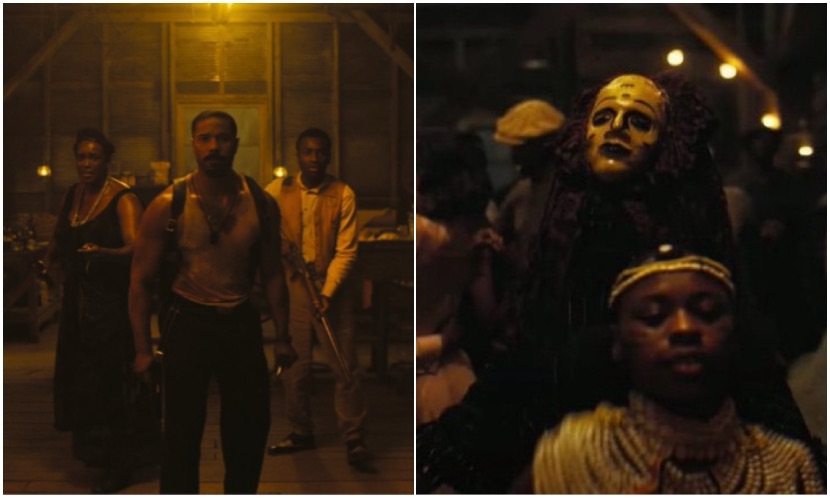NFL
JUST IN: Why Sinners Is More Than a Movie: Insiders Claim Its 1930s Vampire Clan Is a Chilling Allegory for Globalist Elites Controlling the Great Migration—Here’s the Proof!

Why Sinners Is More Than a Movie: Insiders Claim Its 1930s Vampire Clan Is a Chilling Allegory for Globalist Elites Controlling the Great Migration—Here’s the Proof!
By Anonymous TruthSeeker, April 25, 2025
Buckle up, truth-seekers, because Ryan Coogler’s Sinners isn’t just another vampire flick—it’s a carefully crafted puzzle hiding a dark agenda in plain sight. Beneath the surface of this 1930s South horror tale lies a chilling allegory, one that some insiders claim points to globalist elites manipulating the Great Migration for their own sinister ends. From cryptic symbolism to questionable historical references, the evidence is stacking up, and it’s time to pull back the curtain on Hollywood’s latest mind game.

The Setup: A Vampire Clan in the 1930s South
For those who haven’t seen it, Sinners follows twin brothers, played by Michael B. Jordan, caught in a supernatural battle involving a vampire clan in the Deep South during the Great Migration. The film drips with blues music, hoodoo aesthetics, and gritty historical vibes, earning a 99% on Rotten Tomatoes for its bold storytelling. But while critics praise its “cultural depth,” some eagle-eyed viewers are asking: Why set a vampire story during one of the most pivotal moments in Black American history? Is this really about entertainment, or is something far more insidious at play?
The Great Migration as a Globalist Chessboard
The Great Migration, when millions of Black Americans fled the Jim Crow South for northern cities, was a defining moment of the 20th century. It reshaped demographics, economies, and cultural landscapes. But what if it wasn’t just a grassroots movement? According to fringe historians and conspiracy researchers, shadowy elites—think secret societies, banking cartels, or early globalist think tanks—saw the Migration as a chance to destabilize regions, control labor markets, and sow division. And Sinners, some claim, is subtly retelling this story through its bloodsucking vampires.
The film’s vampire clan, led by a charismatic yet ruthless figure, operates in the shadows, preying on vulnerable communities while amassing power. Sound familiar? Insiders allege this mirrors how globalist puppetmasters supposedly exploited the Great Migration, steering Black families into urban centers to serve as cheap labor while fracturing their cultural roots. The vampires’ seductive promises of freedom and power? A metaphor for the false hope dangled by industrial tycoons and political operatives who needed bodies to fuel their factories.
Decoding the Symbolism
Let’s break down the clues. The film’s setting—rural Mississippi in the 1930s—isn’t random. It’s ground zero for the Great Migration’s exodus, a place where systemic oppression pushed families to flee. But notice how Sinners portrays the vampires as both oppressors and liberators. They offer the twins a chance to escape their preacher father’s strict world, but at a horrific cost. This duality, some argue, reflects how globalists allegedly lured migrants with promises of jobs and safety, only to trap them in exploitative urban slums.
Then there’s the blues music, a haunting backbone of the film. While it’s celebrated as a nod to Black culture, conspiracy buffs point out that certain songs in Sinners contain eerie lyrics about “crossing rivers” and “selling souls.” Are these just artistic flourishes, or coded references to crossing state lines under elite influence, trading freedom for servitude? One X post from user @TruthHound88 claims the film’s soundtrack syncs perfectly with a 1930s map of migration routes, suggesting Coogler embedded a hidden blueprint of elite-orchestrated population shifts. Coincidence? We think not.
And don’t overlook the hoodoo elements. The film’s use of spiritual rituals, like protective charms and blood offerings, has sparked debate. Some see it as respectful cultural representation; others call it a dogwhistle for occult practices tied to secret societies. A shadowy figure in the movie, rumored to be a vampire elder, wears a ring eerily similar to symbols linked to early 20th-century fraternal orders. Could this be a nod to the alleged esoteric cabals pulling strings behind the Migration?
The Coogler Connection: Mastermind or Pawn?
Ryan Coogler, the visionary behind Black Panther and Creed, is no stranger to weaving social commentary into his films. But is he knowingly planting these clues, or is he a pawn in a larger Hollywood scheme? Some speculate that Sinners was greenlit by studio elites to normalize their historical machinations, using Coogler’s credibility to cloak their agenda in “cultural authenticity.” Others argue Coogler is exposing the truth, hiding it in plain sight for those brave enough to see.
Either way, the film’s production raises red flags. Why did Warner Bros. fast-track Sinners despite its niche premise? Why did it receive glowing reviews before screenings even began? And why are certain scenes—like a vampire whispering about “controlling the flow of souls”—missing from early scripts leaked on X? These questions fuel suspicions that Sinners is more than art—it’s propaganda.












